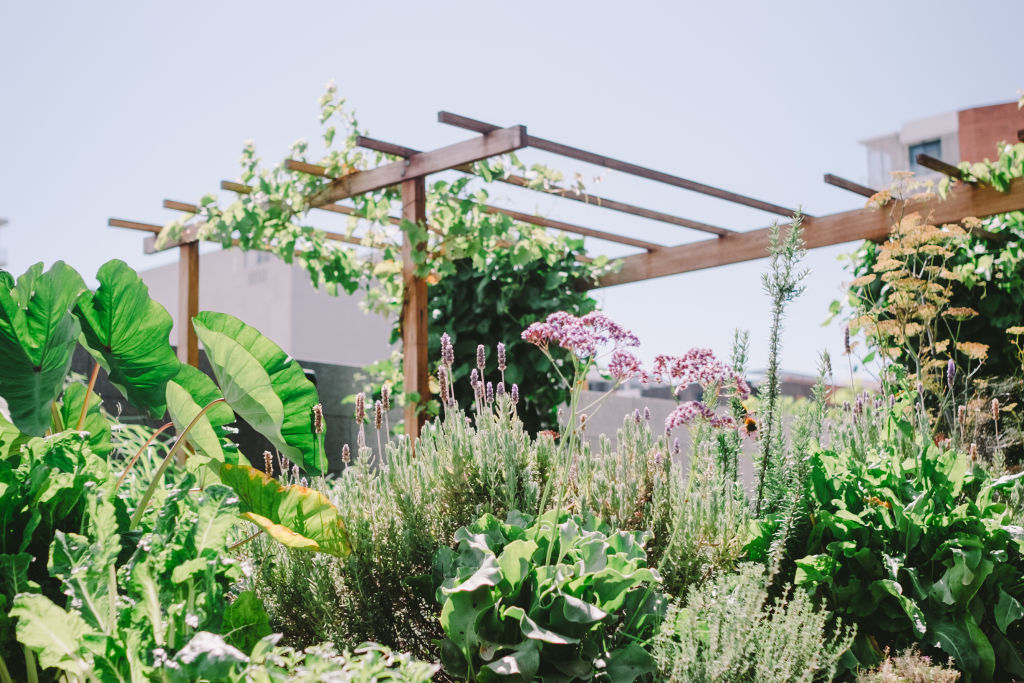Tips for making sure your garden survives the summer months

The first thing I did when we moved into our new home was walk back out the front door and into the garden to start dreaming. What would it look like? What weird and wonderful plants could I find? How would it feel?
Two summers later and it’s still a work in progress, which suits me just fine. I would hate my garden to ever be finished; what would I do then?
As I’m sure most gardeners would agree, being in the garden is not work to me.
Find out how to live more sustainably on episode two of Somewhere Else:
But what is it that we gardeners do out there for hours on end?
To give you some inspiration, I’ve jotted down what I’ve been doing in the lead-up to summer. No matter the style of your garden, this list should give you an idea of what you could be doing to give your place some love in the warmer months.
Edibles
We live about 50 kilometres south of Sydney so our tomatoes, eggplants, kale, chillies, rocket and other herbs and leafy greens were planted in early spring. Most of our herbs and leafy greens are flowering now so we’ll remove them and plant new seeds before the peak of summer. I’ve been using Dipel for caterpillars and diatomaceous earth for slugs and snails.

Lawn
I’ll be pulling out weeds before they set seed, mowing often (not trimming too low to the ground) and giving the lawn a deep watering. I’ve got to remember to check the irrigation battery, frequency and duration of our watering system. And, I guess a game of boules with a cold beer wouldn’t hurt either.
Fertilising
I gave the garden beds and pot plants organic plant food in spring but it’s still worth giving them all a feed now. You can also use a liquid fertiliser to correct any nutrient deficiencies and to promote flowering and fruiting. Seaweed powder mixed with water helps plants in times of stress such as hot summer days.
Mulching
Fresh mulch holds moisture in the soil and helps to maintain a constant soil temperature which prevents heat stress in plants. It also provides an environment for beneficial organisms. Just remember to water your soil thoroughly before mulching. Pea straw or sugar cane mulch is best for edible gardens and fruit trees.
Compost & worm farms
You can add any compost or worm castings to top up garden beds, veggie patches and pot plants. This will add soil biology to new potting mix and replenish your garden soil. Mix water and worm wee 1:10 and give your new plants a drink, especially those edible seedlings.

Bees
We’ll be opening up our beehive a few times over summer to check on the girls’ health and honey stores, as well as harvesting many kilos of the golden stuff. We know what our family will be getting for Christmas. If you want a new hobby for 2020, why not pop a bee hive on your wish list?
Climbers & vines
Most will get out of control over summer – let them put on a flower show, but keep tabs on where they are overstaying the invitation. Keep training them to the pergolas and walls they should be on.
Weeds
I don’t pencil in a date that I’m going to weed the garden, I just pull them out when I see them. Don’t purchase or use any nasty pesticides for your weeds, there are many non-harmful effective products on the market.
Avoid gardening on hot days
No mowing, pruning, planting or any garden work apart from watering in the morning of a day forecast to be over 35 degrees. It’s too stressful for your plants and the beach or swimming hole is a far better option.
Watering
Sometimes it takes an hour, but a deep water once or twice a week is better than a light spray on the leaves every day. This prevents weeds and creates more resilient plants with deeper roots. Give everything a good water before heading away on holidays. Move smaller pots out of the sun and indoor plants outside where they might get some rain.
Slow Down and Grow Something The Urban Grower’s Recipe for the Good Life. By Byron Smith with Tess Robinson, Murdoch Books.
We recommend
States
Capital Cities
Capital Cities - Rentals
Popular Areas
Allhomes
More










